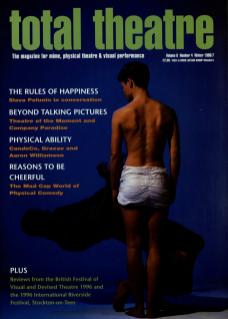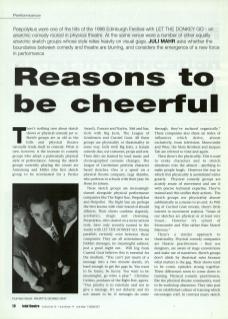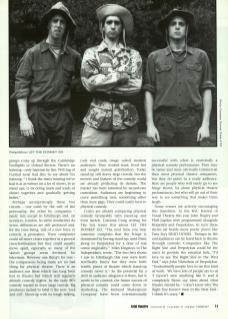There's nothing new about sketch shows or physical comedy per se. Sketch groups are as old as the hills and physical theatre naturally lends itself to comedy. What is new, however, is the increase in comedy groups who adopt a particularly physical style of performance. Among the sketch groups currently playing the circuit are Armstrong and Miller (the first sketch group to be nominated for a Perrier Award), Parsons and Naylor, Mel and Sue, Girls with Big Jests, The League of Gentlemen and Curried Goat. All these groups use physicality or theatricality in some way. Girls with Big Jests, a female comedy duo, use costumes, props and sets. Their skits are framed by loud music and choreographed costume changes. The League of Gentlemen perform character based sketches. One is a spoof on a physical theatre company, Legs Akimbo, who perform in schools with their play No Home for Johnny.
These sketch groups are increasingly classed alongside physical performance companies like The Right Size, Peepolykus and Hoipolloi. The Right Size are perhaps the best known with their brand of absurd silliness. Their shows combine slapstick, acrobatics, magic and clowning. Peepolykus, who started on a more serious note, have only recently turned to the wacky with Let the Donkey Go. Strong parallels certainly exist between these companies. They are all entertainers: no hidden messages, no meaningful subtext; just a good night out. Will Ing from Curried Goat believes this is essential for the medium. ‘You can't put much of a message into a two minute sketch, it's hard enough to get the gags in. You want to be funny, be funny. You want to be meaningful, go write a play.’ Christine Gettins, producer of the Right Size, agrees. ‘Our priority is to entertain and not to give a message. It's not didactic and it's not meant to be. If messages do come through, they've surfaced organically.’ These companies also share an index of influences which derive, almost exclusively, from television: Morecombe and Wise, the Marx Brothers and Jacques Tati are referred to time and again.
Then there's the physicality. This is used to evoke characters and to stretch situations into the absurd – anything to make people laugh. However, the way in which this physicality is assimilated varies greatly. Physical comedy groups are acutely aware of movement and use it with precise technical expertise. They're trained and this unifies their actions. The sketch groups use physicality almost subliminally as a means to an end. As Will Ing of Curried Goat reveals, there's little interest in movement analysis. ‘Some of our sketches are physical or at least very visual... However it's school of Morecombe and Wise rather than Marcel Marceau.’
There's a similar approach to theatricality. Physical comedy companies are theatre practitioners – they use designers, are aware of stage conventions and make use of narratives. Sketch groups don't abide by theatrical rules because what matters is the gag. Their shows tend to be comic episodes strung together. These differences seem to come down to training. Physical comedy practitioners, like the physical theatre community, tend to be workshop obsessives. They take part in an established culture of training which encourages craft. In contrast many sketch groups come up through the Cambridge Footlights or Oxford Review. There's no training – only baptism by fire. Will Ing of Curried Goat had this to say about his training: ‘I think the main training we've had is a) as writers on a lot of shows, b) as stand ups, c) by doing loads and loads of shows together and gradually getting better.’
Perhaps unsurprisingly these two circuits – one ruled by the cult of the personality, the other by companies – rarely mix except in Edinburgh and, on occasion, London. So while similarities do occur, differences are still profound and, for the time being, talk of a new force in comedy is premature. These companies could all move closer together in a general cross-fertilisation but they could equally move apart, especially as many of the sketch groups seem destined for television. However, one thing's for sure – the comparisons being made are no bad thing for physical theatre. There is an audience out there which has long been lost to theatre but which still regularly attends comedy nights. In the early 80s comedy started to draw large crowds. Big producers rushed to label it the new 'rock and roll'. Stand-up with its tough talking, rude and crude image suited modern audiences. They worked hard, lived fast and sought instant gratification. Today stand-up still draws large crowds, but the movers and shakers of the comedy world are already predicting its demise. The market has been saturated by second-rate comedians. Audiences are beginning to crave something new, something other than mere gags. They could easily turn to physical comedy.
Critics are already comparing physical comedy favourably with stand-up and even sketch. Catriona Craig writing for The List wrote this about Let the Donkey Go: ‘The next time you hear someone complain that the Fringe is dominated by boring stand-up, send them along to Peepolykus for a dose of real comic originality.’ Miles Kingston, in The Independent, wrote: ‘The two best shows I saw in Edinburgh this year were both terrifically funny but they were both terrific pieces of theatre which stand-up comedy never is.’ So the potential for a shift in audience allegiance is there, but it needs to be courted; the future success of physical comedy could come down to marketing. The Reduced Shakespeare Company have been internationally successful with what is essentially a physical comedy performance. They may be tamer and more obviously commercial then most physical theatre companies, but they do point to a ready audience. Here are people who will rarely go to see fringe shows, let alone physical theatre performances, but who will go out of their way to see something that makes them laugh.
Some venues are actively encouraging this transition. At the BAC Festival of Visual Theatre this year John Hegley and Phil Jupitus were programmed alongside Hoipolloi and Peepolykus. In turn these shows sat beside more poetic pieces like Tmu-Na's Dead Hours. Perhaps in the end audiences can be lured back to theatre through comedy. Companies like The Right Size and Peepolykus could be the ones to provide the essential link. ‘I'd love to see The Right Size in the West End,’ says John Nicholson of Peepolykus. ‘Undoubtedly people love to see this kind of work. We have lots of people say to us “I haven't seen anything like it and it completely blows my ideas about what theatre should be.” I don't know why The Right Size haven't been in the West End – I think it's crazy.’


